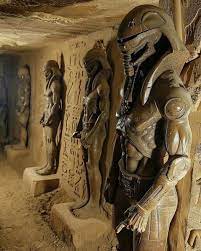Archaeologists Recently Made a Shocking Discovery, Finding Giant Monsters Buried Under the Sands in Egypt
The assertion that archaeologists recently made a “shocking discovery, finding giant monsters buried under the sands in Egypt” is a fictional and sensationalized claim. This type of story is a common internet hoax, often created by digitally altering images of real archaeological digs. While the sands of Egypt are a treasure trove of incredible discoveries, from pharaonic tombs to lost cities, they have never yielded the remains of mythical “giant monsters.”

The concept of colossal beings and fantastical creatures is deeply woven into the rich tapestry of ancient Egyptian mythology. Figures like Ammit, a chimerical beast with the head of a crocodile, the body of a lion, and the hindquarters of a hippopotamus, and Apep, the colossal serpent of chaos, were central to their beliefs about the afterlife and the cosmic order. However, these creatures were purely symbolic, representing the fearsome forces of nature and the gods. They exist in hieroglyphs, papyri, and temple art, not in the physical archaeological record.

Real archaeological discoveries in Egypt are no less spectacular, even without the mythical monsters. Recent finds, such as a large “anomaly” found under the Giza pyramids by ground-penetrating radar, have captivated the public. While initial speculation might run wild, these anomalies typically turn out to be things like previously undiscovered subterranean structures or burial chambers, not mythical creatures. In a field governed by meticulous science and peer-reviewed evidence, any claim of discovering a dragon or a giant would be met with rigorous skepticism and would require definitive proof—something that has never been provided.
